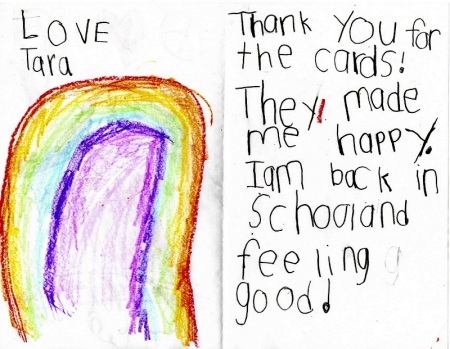Carolyn’s Shade Gardens is a retail nursery located in Bryn Mawr, PA, specializing in showy, colorful, and unusual plants for shade. The only plants that we ship are snowdrops and miniature hostas. For catalogues and announcements of events, please send your full name, location, and phone number (for back up use only) to carolyn@carolynsshadegardens.com. Click here to get to the home page of our website for catalogues and information about our nursery and to subscribe to our blog.
 The green halo in this beautiful hybrid hellebore flower probably results from the influence of H. torquatus, which is characterized by a pale collar around the center of the flower.
The green halo in this beautiful hybrid hellebore flower probably results from the influence of H. torquatus, which is characterized by a pale collar around the center of the flower.
Hybrid hellebores, Helleborus x hybridus (the Royal Horticultural Society approved name, previously called Lenten rose or Orientalis hybrids), are the most commonly available hellebores with the large, showy, nodding flowers in an amazing range of colors (click here and here to see photos). In my article An Ode to Seed Strain Hellebores, I explained my fascination with and love of the diversity found in hybrid hellebores .
I described how, unless tissue cultured, you can’t be sure what a hybrid hellebore flower will look like unless it is in bloom. But I pointed out that to me that is the magic of hybrid hellebores: each plant is a unique individual, with the potential for inheriting genetic material from any of the 9 species hellebores that could be its parents. In this article, I want to explain exactly where hybrid hellebores come from and introduce you to their parents. If you want to skip the technical discussion, photos of the parent species are at the end of the article. I won’t be insulted.
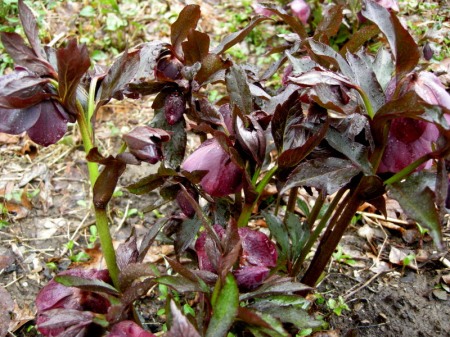 The leaves of ‘Metallic Blue Lady’ hybrid hellebore come out a deep glossy purple showing the influence of H. atrorubens, which can have the same attribute.
The leaves of ‘Metallic Blue Lady’ hybrid hellebore come out a deep glossy purple showing the influence of H. atrorubens, which can have the same attribute.
The genus Helleborus contains between 12 and 21 species, depending on who is counting, but I usually stick with the 15 described by Brian Mathew, Royal Botanic Gardens, Kew, in his authoritative work Hellebores (Alpine Garden Society 1989). Six of these species are not relevant to our discussion here. The other nine species are the parents of hybrid hellebores. They are H. atrorubens, H. cyclophyllus, H. dumetorum, H. mulitifidus, H. odorus, H. orientalis, H. purpurascens, H. torquatus, and H. viridis.
These nine hellebore species have crossed and re-crossed naturally and through human intervention by hellebore breeders over hundreds of years to produce hybrid hellebores. That is why hybrid hellebores are so variable: they can have the characteristics of any of these nine species in their background in infinite combinations. And it is impossible to be sure which species a particular hybrid hellebore has in its genetic makeup, although flower and leaf characteristics can often lead one to speculate that a particular parent might be predominant (see two photos above).
The species themselves are also incredibly variable in the wild, often freely crossing with each other, making them difficult to identify. For a discussion of just how variable, read Chapter 3 in Hellebores: A Comprehensive Guide by J. Tyler and C. Burrell (Timber Press 2006).
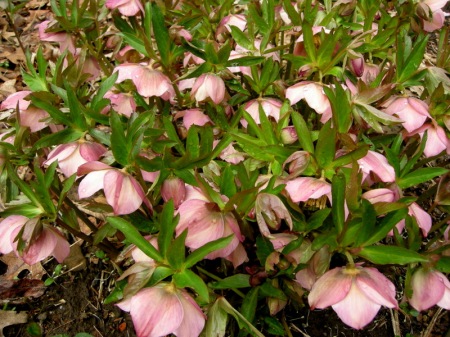 This very beautiful but clearly hybrid hellebore was sold to me as H. purpurascens.
This very beautiful but clearly hybrid hellebore was sold to me as H. purpurascens.
I was a hellebore fanatic long before I became a galanthophile (see my article Snowdrops: Further Confessions of a Galanthophile), and over the years I have collected, grown, and, in some cases, sold to my customers all 15 species, which are all very beautiful in their own right. In addition, I have attempted to acquire them from as many different sources as possible in order to get plants that I consider the most true to type. Many of my plants were grown from seeds collected in the wild by Will McLewin of Phedar Nursery in the U.K. You would be amazed at what I have been sold as species hellebores (see photos above and below).
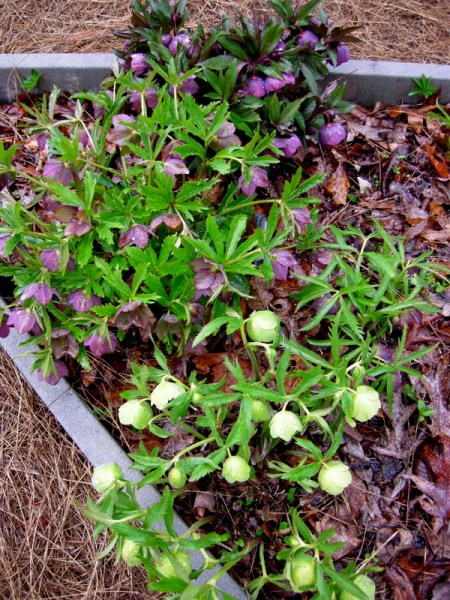 These four plants were all sold to me as H. atrorubens.
These four plants were all sold to me as H. atrorubens.
So over the years, through trial and error, I have developed what I jokingly call the “U.S. National Species Hellebore Collection”, and I present them to you. But please remember that I have never actually seen these plants in the wild.
Helleborus cyclophyllus
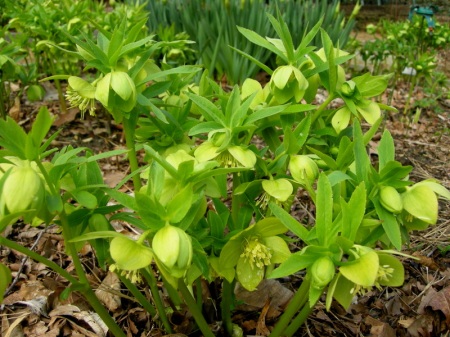
 Helleborus cyclophyllus is native to the open dry hillsides and woods of Greece, Albania, the former Yugoslavia, and Bulgaria. Its name means with leaves in a circle. It is quite fragrant and not ornamentally distinct from H. odorus, fragrant hellebore. All the chartreuse-flowered species hellebores look gorgeous in combination with red- and purple-flowered hybrids.
Helleborus cyclophyllus is native to the open dry hillsides and woods of Greece, Albania, the former Yugoslavia, and Bulgaria. Its name means with leaves in a circle. It is quite fragrant and not ornamentally distinct from H. odorus, fragrant hellebore. All the chartreuse-flowered species hellebores look gorgeous in combination with red- and purple-flowered hybrids.
Helleborus atrorubens
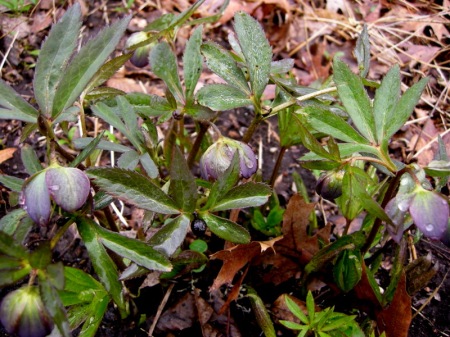
 Helleborus atrorubens is native to dry hillsides and woodland margins of the former Yugoslavia. Its name means dark red, and it gives purple and red colors to hybrid hellebores. It can also contribute the desirable attribute of leaves that emerge dark purple.
Helleborus atrorubens is native to dry hillsides and woodland margins of the former Yugoslavia. Its name means dark red, and it gives purple and red colors to hybrid hellebores. It can also contribute the desirable attribute of leaves that emerge dark purple.
Helleborus dumetorum
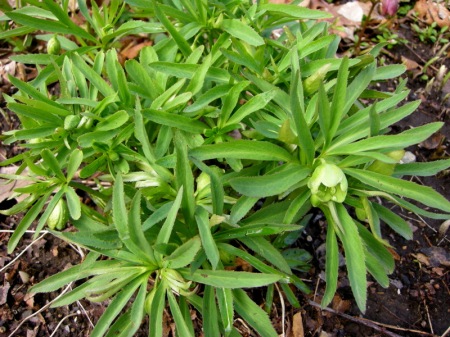
 Helleborus dumetorum is native to the mountainous woods and thickets of Austria, Romania, the former Yugoslavia, and Hungary. Its name means of thickets and hedgerows. At 8 to 12″ (all the others are 12 to 20″), it is the smallest hellebore species and looks like a miniature. Its multiple skinny leaflets give it a feathery appearance.
Helleborus dumetorum is native to the mountainous woods and thickets of Austria, Romania, the former Yugoslavia, and Hungary. Its name means of thickets and hedgerows. At 8 to 12″ (all the others are 12 to 20″), it is the smallest hellebore species and looks like a miniature. Its multiple skinny leaflets give it a feathery appearance.
Helleborus purpurascens


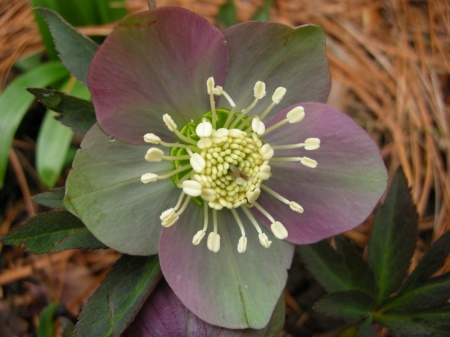 Helleborus purpurascens is native to light woodlands and meadows throughout eastern Europe. Its name means purplish, and it usually doesn’t exceed 12″ tall. It is my favorite of the species both for its gorgeous and unusual flowers and its circular, filigreed leaves. It must be more stable in the wild because every plant I have acquired looks similar to the photos above.
Helleborus purpurascens is native to light woodlands and meadows throughout eastern Europe. Its name means purplish, and it usually doesn’t exceed 12″ tall. It is my favorite of the species both for its gorgeous and unusual flowers and its circular, filigreed leaves. It must be more stable in the wild because every plant I have acquired looks similar to the photos above.
Helleborus odorus (Fragrant Hellebore)
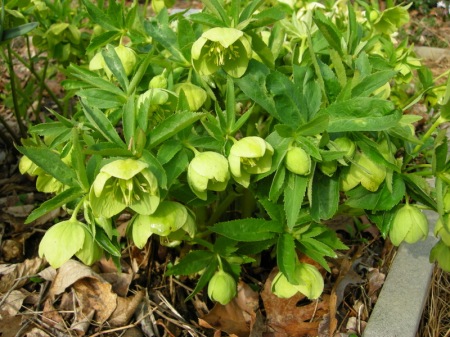
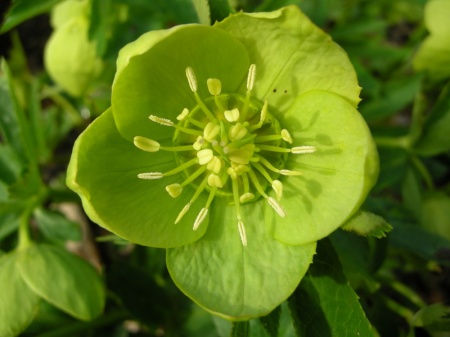 Helleborus odorus is native to woodland margins and thickets of Hungary, Romania, and the former Yugoslavia. Its name means fragrant, and it is one of the more commonly grown species. On warm days, H. odorus and H. cyclophyllus perfume my whole species hellebore area. I have never noticed that this trait was passed on to any hybrid flower. As noted above, it is not ornamentally distinct from H. cyclophyllus.
Helleborus odorus is native to woodland margins and thickets of Hungary, Romania, and the former Yugoslavia. Its name means fragrant, and it is one of the more commonly grown species. On warm days, H. odorus and H. cyclophyllus perfume my whole species hellebore area. I have never noticed that this trait was passed on to any hybrid flower. As noted above, it is not ornamentally distinct from H. cyclophyllus.
Helleborus torquatus

 Helleborus torquatus is native to light deciduous woods and clay soil of the former Yugoslavia. Its name means with a collar, referring to the pale ring around the neck of the flower, which you can see in the photo above. Its leaves have 15 to 25 long tapering segments giving the whole plant a unique spidery look. It produces double flowers in the wild and also contributes purple and blue color and metallic highlights to the hybrids. It is the rarest of the species in this article, and I have only been able to acquire it from one source.
Helleborus torquatus is native to light deciduous woods and clay soil of the former Yugoslavia. Its name means with a collar, referring to the pale ring around the neck of the flower, which you can see in the photo above. Its leaves have 15 to 25 long tapering segments giving the whole plant a unique spidery look. It produces double flowers in the wild and also contributes purple and blue color and metallic highlights to the hybrids. It is the rarest of the species in this article, and I have only been able to acquire it from one source.
Helleborus viridis (Green Hellebore)
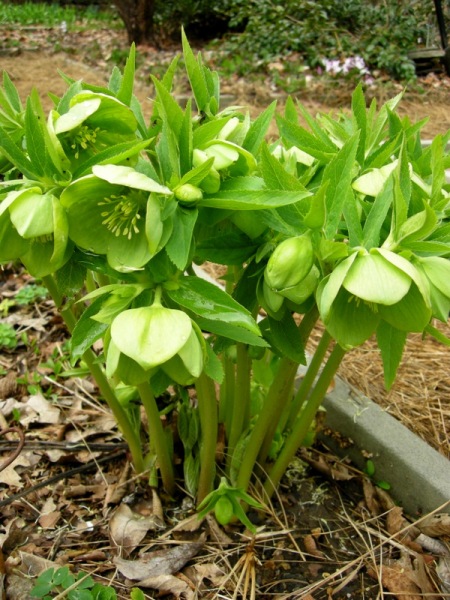
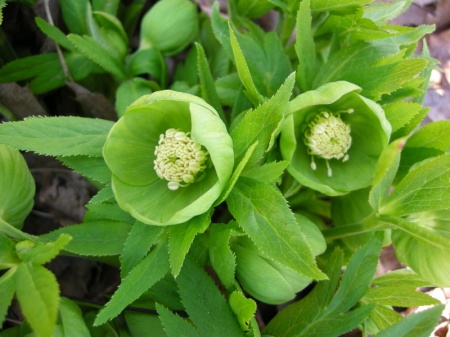 Helleborus viridis is unusual culturally and geographically because it is native to the moist deciduous woods and meadows and clay soil of western Europe and the U.K. Most of these species hellebores require well-drained soil and are native to eastern Europe. Its name means green, and its flowers are certainly the best green of the species. I find them quite beautiful.
Helleborus viridis is unusual culturally and geographically because it is native to the moist deciduous woods and meadows and clay soil of western Europe and the U.K. Most of these species hellebores require well-drained soil and are native to eastern Europe. Its name means green, and its flowers are certainly the best green of the species. I find them quite beautiful.
Helleborus orientalis (Lenten Rose)
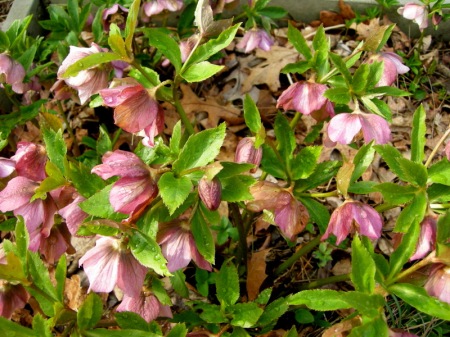
 There are three subspecies of Helleborus orientalis, the Lenten rose. The photos above are of a plant sold to me as H. orientalis subsp. abchasicus. However, because of the green carpels and spotted flowers, I am inclined to think it is subsp. guttatus. The seed came from well known hellebore expert Will McLewin. It is native to open fields as well as scrub and woodlands of the Caucasus Mountains where Europe meets Asia, which explains its name meaning of the Orient. Most hybrid hellebores are derived at least in part from H. orientalis, which is why they were originally called Orientalis hybrids.
There are three subspecies of Helleborus orientalis, the Lenten rose. The photos above are of a plant sold to me as H. orientalis subsp. abchasicus. However, because of the green carpels and spotted flowers, I am inclined to think it is subsp. guttatus. The seed came from well known hellebore expert Will McLewin. It is native to open fields as well as scrub and woodlands of the Caucasus Mountains where Europe meets Asia, which explains its name meaning of the Orient. Most hybrid hellebores are derived at least in part from H. orientalis, which is why they were originally called Orientalis hybrids.
Helleborus multifidus
Helleborus multifidus is native to the deciduous woods and open scrubland of Italy, the former Yugoslavia, and Albania. Its name means much divided, referring to its beautiful frilly leaves. I grow three of its four subspecies, which I treasure for their foliage, and two are pictured below.
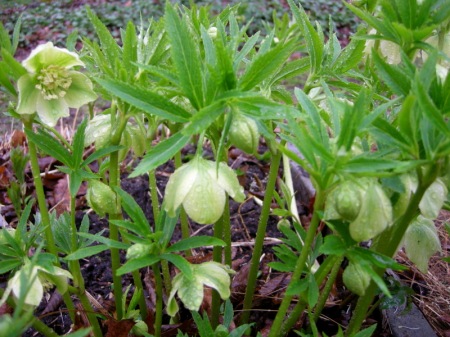
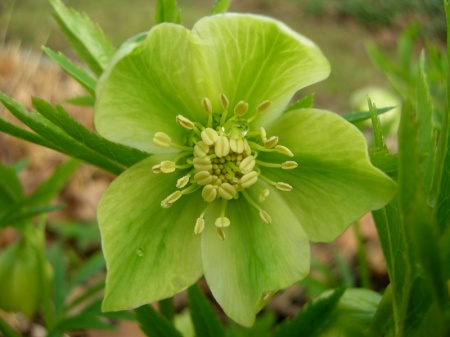 Helleborus multifidus subsp. bocconei is a variant from central and southern Italy and Sicily named for a Sicilian botanist. It is said to be a better garden plant than the other subspecies and certainly makes a gorgeous lacy statement in my gardens.
Helleborus multifidus subsp. bocconei is a variant from central and southern Italy and Sicily named for a Sicilian botanist. It is said to be a better garden plant than the other subspecies and certainly makes a gorgeous lacy statement in my gardens.
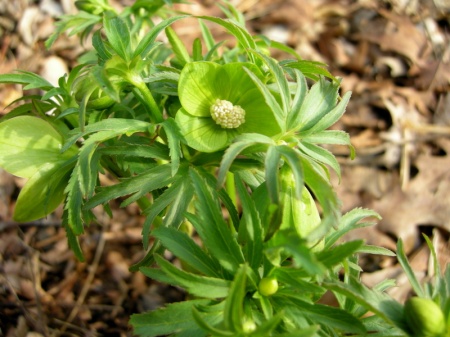
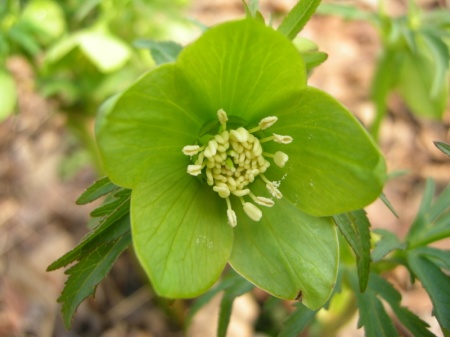 Helleborus multifidus subsp. hercegovinus is native to Bosnia and Herzegovina. It is definitely harder to grow but well worth the effort for its extraordinary leaves, which can be divided into 100 leaflets.
Helleborus multifidus subsp. hercegovinus is native to Bosnia and Herzegovina. It is definitely harder to grow but well worth the effort for its extraordinary leaves, which can be divided into 100 leaflets.
I hope you have enjoyed my photo gallery with short descriptions for each of the nine hybrid hellebore parents. I have spared you many details that interest me as a collector. I felt that this was enough to take in in one article. I should probably also mention that none of the photos above picture the true leaves of the plants, which come out after the flowers. What you are seeing above are the bracts, which are part of the flower stem and often reflect the leaf characteristics. If readers are truly interested, I could photograph the leaves, which in many cases are extraordinary, for a later article.
I would really appreciate reader feedback on your experiences with these species, and I would especially like to know if you think any of them are mislabeled and why.
Caroly
This is part of a series of articles on hellebores, one of the specialties of my nursery. Here are links to the other articles:
Part One Hellebores for Fall
Part Two An Ode to Seed Strain Hellebores
Part Three Christmas Rose: The Perfect Hellebore
Part Four Dividing Hybrid Hellebores
Part Five The Sex Lives of Hellebores
Part Six Double Hellebores
Part Seven Cutting Back Hellebores
Notes: Every word that appears in orange on my blog is a link that you can click for more information. If you want to return to my blog’s homepage to access the sidebar information (catalogues, previous articles, etc.), click here.
Nursery Happenings: I sell several of the species hellebores pictured above so if you are interested send me an email (no mail order). My next nursery event is Bulb and Native Wildflower Day on April 9 from 10 am to 2 pm.
Thanks from Tara:
In my post I Need Your Help, I asked you to send cards to Tara, the five-year-old daughter of Kartik whom I profiled inNew Year’s Resolution to Edit the Garden. Tara had recently been diagnosed with leukemia. As a result of your generosity, Tara received cards from all over the world and has sent you one in return.
